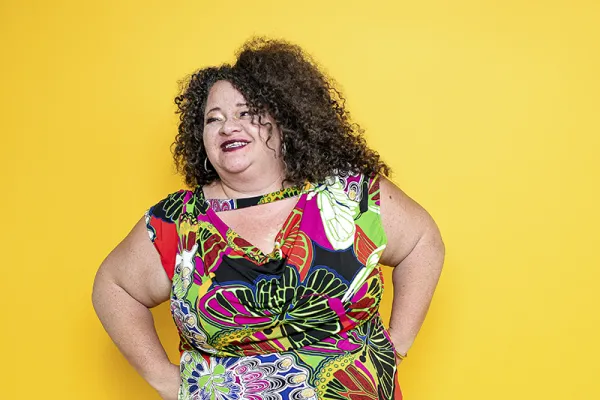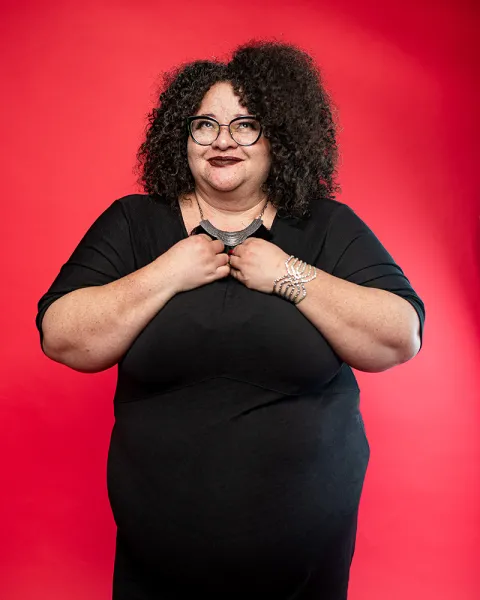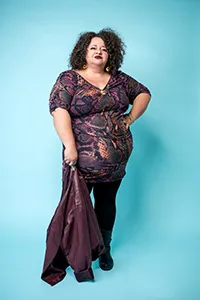Eye of the Tigress
Alumnae News
Fat activist Tigress Osborn ’96 is a force to be reckoned with

Published March 25, 2023
As a first-year Smith student, Tigress Osborn ’96 attended a Cromwell Day workshop on fat acceptance. “I wasn’t that fat, but I had a strong identity as a fat girl,” she says. “I was being told all the time that I needed to lose weight.”
At that workshop, she first learned about the National Association to Advance Fat Acceptance (NAAFA) and the fat acceptance movement. It made a lasting impression. “I felt like there was a whole different way to think about size,” Osborn says. “My aunts were the Lizzos of my neighborhood, but they still talked about how they should be on SlimFast.” She felt empowered by the idea that you could be unashamedly fat.
Osborn has led NAAFA since 2021. Founded in 1969, the nonprofit is the oldest organization dedicated to making the world more equitable for fat people through education, advocacy, and support. Osborn is the first person of color to head NAAFA. “Part of my focus has been to bring a more intersectional lens to that work,” she says. “We know that people marginalized in other ways are exponentially impacted by anti-fat attitudes.”
And, yes, “fat” is the word of choice. “Many fat liberationists believe that you can’t destigmatize a word that you won’t use,” Osborn says. “We use the word, positively or neutrally, but we use it, and we encourage other people to use it in that way. I think it was at Smith that I learned to question the term ‘overweight.’ What’s the ideal weight that one person is over and somebody else is not over?”
“My aunts were the Lizzos of my neighborhood, but they still talked about how they should be on SlimFast.”
Osborn, who lives in Arizona, where she was raised, majored in Africana studies at Smith and holds a graduate degree in creative writing from Mills College. Her professional background includes work in diversity, equity, and inclusion as well as in fat activism. In 2008, while working as a high school diversity educator by day in Oakland, California, she founded Full Figure Entertainment (FFE), staging hip-hop dance events welcoming to fat people at nightclubs in the Bay Area. “The fat girls were the main event, though everyone was welcome,” says Osborn, who served as producer, host, and promoter. Her night job very much related to her day job. She jokes that she is probably the only club promoter who ever issued a mission and values statement. “My goal was to throw the hottest party in the Bay on Friday nights, ultimately making the world a better place for fat girls,” she says.
Through her work with FFE over the next nine years, Osborn also established a team of models and produced fashion shows. But she is most proud of the small victories of her patrons: “Some of my favorite success stories are the women who came to the party and stood by the wall the first time, but who got increasingly more confident in their fashion choices and in their willingness to interact with people just from being in that supportive environment.”

“Weight stigma is woven into the very fabric of our culture, and it takes interrupters of all sizes to unweave it,” says Osborn.
It’s an exciting time for NAAFA and the fat acceptance movement, as several states and cities across the country—New York state, New York City, Massachusetts, New Jersey, and Vermont—consider legislation to make size discrimination illegal. Osborn and NAAFA are working to help pass this legislation, in addition to continuing their advocacy and relationship building with businesses and organizations such as the Association for Size Diversity and Health and the Retail, Wholesale and Department Store Union. NAAFA also offers programming, stages virtual social events, and engages its members in discussions on a broad spectrum of topics, including body image and eating disorders as well as the intersection of fatness with other identities.
“Throughout my life, people around me and the greater culture have always told me what I wasn’t supposed to do until I lost weight,” Osborn says. “Everything I do that’s a rejection of that falls under the umbrella of fat activism.”
“We can’t cure social justice issues by changing people’s bodies. We must change the injustice itself, because there have always been fat people, and there always will be.”
Here, Osborn discusses size discrimination, why it matters, and what we can do about it.
Describe the systemic discrimination against fat people.
Anti-fatness is an intersectional social justice issue that creates deep and life-altering—sometimes life-threatening—hurdles for fat people and anyone perceived as fat. Anti-fatness shows up in literally every system we have— employment, housing, education, justice, health care— everything. It means you are among the most harassed on social media platforms but also among the least protected by those platforms’ anti-discrimination and anti-bullying policies. Anti-fatness means being misrepresented, underrepresented, and even completely erased in the media. For people who are fat and have other marginalized identities, the systemic discrimination is compounded. This is especially true for Black and Brown people, because our culture’s understanding of fat, beauty, and health is based in racist ideals.
What are some of the consequences of anti-fatness?
The results include workplace discrimination ranging from fat people paying more for benefits to losing opportunities to getting paid less than thin counterparts with the same qualifications. The same medical system that purports to be in favor of your health routinely denies you care, and the professionals in that system routinely ignore the actual symptoms you present and focus only on your body size. Schools, businesses, and other places are willing to exclude you rather than create spaces that fit you and welcome you. People of your size are left out of scientific research, products are created without consideration as to whether they will work for you, and clothing manufacturers ignore you.
Discuss the status of size discrimination legislation in America today. How do other countries compare?
Today, in the United States, there is no federal law protecting against discrimination based on body size. There are only two states—Michigan and Washington—where size discrimination is prohibited. In Michigan, fat people are Washington, by a state Supreme Court decision classifying obesity as a form of disability. There are a handful of cities that include height and weight in their municipal protections, either specifically by body size or generally by protecting against appearance-based discrimination. Globally, Brazil has the most legal protections for fat people. Reykjavík, Iceland, also has some protections. Canada’s “one person, one fare” rule prevents fat people from being charged for two seats for air travel, as they are in other countries, including the United States.
What are you and NAAFA doing to help pass this legislation?
NAAFA is partnering with the Fat Legal Advocacy, Rights, and Education Project to build a coalition with other organizations to support any locale that wants to help end size discrimination. We are also building coalitions with other fat advocacy organizations, plus-size groups, and Little People of America, which provides support to people of short stature and their families. That is in addition to working across causes to build ongoing relationships with racial justice, LGBTQIA rights, and disability rights groups.
Discuss the importance of ending discrimination against fat people.
Anti-fatness destroys lives. It’s as serious as that. It upholds racism, sexism, and ableism. It destroys people’s mental health and economic stability. It tries to shut people out of society, and it tries to force us to be something many of us simply cannot, or will not, be. Fat people exist in every identity group. If we don’t work together to fix all injustice, any success we have in moving toward equity is undone by the reality that anti-fat discrimination limits people’s lives. All forms of oppression are interconnected. We need to support each other’s causes.
What has changed for the better over the past 10 years?
Fashion accessibility is still a problem for fat people, especially those who are “superfat” or “infinifat” [size categories on the fat spectrum]. But it’s better than it was a decade ago, and so is the representation of fat people of all genders in many areas of fashion. More well-being advocates are pushing back against health and beauty standards that exclude anyone who is not white, thin, young, and nondisabled. This includes medical professionals who are going against the grain of their profession to insist that their colleagues examine weight bias in care and treatment and hold them accountable to do better. Social justice spaces that were unwelcoming to fat people are taking on battling anti-fatness as part of their intersectional politics. Fat liberation communities—including NAAFA—are finally addressing the ways we have too often failed at equity and inclusion by creating white-centered heteronormative spaces. We’re all getting better at working together, and we’re getting better at advocating for the most disenfranchised people.
What has changed for the worse?
The American Medical Association’s 2013 decision to designate obesity as a disease is defended by some as taking the blame off fat people for being fat and enabling them to obtain better health care. But the medicalization of fat has deepened weight stigma by strengthening people’s beliefs that fat is something we need to rid the world of by any means necessary. We are so convinced that fat is deadly that we ignore all evidence to the contrary—and there is evidence to the contrary. We use “But what about their health?” as justification to “motivate” fat people to lose weight by treating fat people badly, and we now do that with a level of institutional backup that is more intense than ever. We take the sociocultural issues faced by fat people and, instead of eliminating unfair treatment, we try to eliminate fat people through medical intervention. We can’t cure social justice issues by changing people’s bodies. We must change the injustice itself, because there have always been fat people, and there always will be.
In terms of the arts and popular culture, who or what has done the most for the image of fat people?
We see more fat people in the media than we did a decade ago, but it’s still lagging far behind and still so often based in stereotype that it would be laughable to call it true representation. Independent media and self-created media in the form of social media and blogs are where we see the most authentic representations of fat people. Fat performers like Lizzo, actor/comedian Naomi Watanabe, and Emmy Award winner Nicole Byer, who present fatness brazenly, are getting a lot of media attention, but at the same time, many movies and TV shows don’t use fat extras, let alone fat people in major roles. We see more accolades for actors in fat suits than for performers who live in fat bodies every day of their lives. It’s important to realize that until we see fat people in all forms of media, we’re not reflecting the world we live in.
How can allies of fat people assist in ending discrimination?
Weight stigma is woven into the very fabric of our culture, and it takes interrupters of all sizes to unweave it. Allies often have more resources, access, and power. They should use it in every possible way: Give up space to someone who needs more, plan social events at restaurants that are accommodating to larger bodies, or choose a bridesmaid’s gown that will not cost your plus-size friend more money. Learn more about fat liberation. Examine your own anti-fat attitudes. Being a good ally also includes taking a stand in professional and political arenas: Demand a stop to workplace weight-loss programs, support fat causes with money and time, and write to representatives who will vote on laws that make the world better for people of all sizes.
What is the most important thing you would like people to know?
The world should be prepared for the continued acceleration of the audacity of fat people. Do we dare assert that we are entitled to all that is good in life without having to lose weight to get it? Oh, yes, we do! We are only going to get louder about our rights and more unapologetic about our bodies.
What would you like to see accomplished over the next 10 years?
At the beginning of the year, NAAFA released a report on how the media covers—or rather, doesn’t cover—fat people other than in weight-loss and health narratives. I’d love to see a 10-year anniversary of that report that can honestly say that fat people are being truly represented in every corner of the media. I’d love to see the medical establishment ban the BMI [body mass index; see sidebar] as a measurement of health and classify fat as a natural part of human diversity. I’d also love to see a federal regulation banning size discrimination. But, mostly, I’m looking forward to seeing increasingly more fat people demand fair treatment and more thin people support that in our everyday lives—whether the law requires it or not.
Cheryl Dellecese is a senior editor at Smith.
The article appears in the Spring 2023 issue of the Smith Alumnae Quarterly.
Tigress’ Tips for Fighting Weight Stigma

USE THE WORD “FAT”
→ “Fat” can and should be a neutral descriptor of bodies. Terms like “plus size,” “higher weight,” or “larger bodied” are good alternatives if you’re not ready to own “fat” or you’re in a setting where it might hurt people. But, as much as possible, just say the “F” word.
QUESTION THE DESIGNATION OF FAT AS UNHEALTHY
→ Learn more about how weight-neutral approaches to health, including Health at Every Size practices, improve health outcomes for people of all sizes.
DON’T MAKE EVERYTHING ABOUT HEALTH AND BEAUTY
→ Health and beauty standards shape the way we see fat and treat fat people. But anti-fatness is about more than what people think about how fat people look and feel. Fat people experience discrimination in employment, education, housing, the justice system, gender-affirming care, accessibility aids, and more. Fat people deserve fair and equitable treatment under the law and in the culture.
LOOK BEYOND LIZZO
→ The unapologetic energy Lizzo brings to living her best life in the body she has right now inspires millions globally. But people of all sizes need more than one fat role model. Uplift and amplify fat people at every level of media.
SUPPORT FAT LIBERATION WITH YOUR TIME AND MONEY
→ The fat liberation movement is an incredibly under-resourced social justice movement. Donate to or volunteer for organizations like NAAFA, the Association for Size Diversity and Health, or NOLOSE—all 501(c)(3) charitable organizations.
Photographs by Earle Tubbs